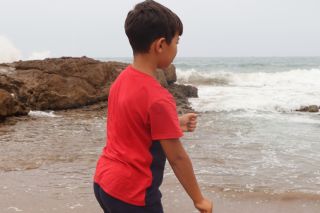Spirituality
Therapeutic Benefits of Awe
A Personal Perspective: Finding awe in our lives.
Posted June 12, 2023 Reviewed by Jessica Schrader
Key points
- A spiritual state can lead to the development of awe.
- As a result of awe, we may develop a better understanding of our role in this world.
- Awe can help us improve ourselves, including through becoming more compassionate and creative.

I teach my students and patients to use spirituality as part of their healing and gaining a better self-understanding.
A spiritual state can be defined as encompassing a feeling of being part of something greater than the self, such as in the context of organized religions, or intimate awareness of the grandeur of the universe, nature, and even creative works such as art, music, and architecture.
A spiritual state can lead to the development of awe, which can include a sense of wonder, as well as reverential respect or fear. As a result of awe, we may develop a better understanding of our role in this world, which can lead us to improving ourselves including through becoming more compassionate and creative.
To develop a better understanding, I wanted to find a spiritual experience within nature when I traveled to northern California a few years ago. I brought my wife to Point Lobos State Natural Reserve, near Monterey Bay, which I still recalled from my childhood as having the most beautiful coastline I had ever seen. Indeed, the Point Lobos shore remained as stunning as I remembered with its rugged cliffs and sandy beaches contrasting with the white foam of crashing waves against rocky outcrops within the blue waters of the Pacific Ocean.
I felt calmer as I stood on a cliff looking down at the Point Lobos shore, but wondered why I did not sense any awe, even though many people have reported finding awe in nature. So, we continued our exploration of nature further down the coast at the Pfeiffer Big Sur State Park. There, among picturesque hiking trails, I came across a grove of redwood trees. Still searching for a spiritual moment, I decided to place my left hand on the trunk of the tallest tree I saw in the grove and thought about passing healing energy into the tree.
As I did so, a thought came into my mind, as if the tree spoke to me. “I don’t take energy, I give energy. I collect it from the sun and distribute it.” That made sense to me, and so I kept my hand on the tree trunk and stood there for a few moments in order to accept its energy. I reflected that this was an awe-filled moment.
Six months later, I was working with a 14-year-old patient who used hypnosis to interact with his subconscious. He decided to ask himself whether he had ever been reincarnated and was told that he had. In response to more of his questions, his subconscious told him that in previous lives he had also been an animal and a tree. He asked if in this life he had ever visited the place in which he had been a tree. He was told he had. My patient then listed several locations to which he had traveled throughout the United States, and then asked if he had been a tree in Big Sur. His subconscious told him that this was the location.
My patient reached into his pocket and pulled out a pocketknife that was decorated with the bark of a redwood tree from Big Sur. I felt gratitude and awe in considering the implications of a possible guiding universe that can account for such synchronicity between my patient’s and my own experiences. I recognized that belief in such a universe can help achieve a calmer and reassuring life perspective. Also, I realized how fortunate I am to be able to experience moments of awe as part of my daily work with my patients.
I wondered if I did not initially find awe in nature because I have been used to spontaneously feeling awe during interactions with my students and patients, while during my travels I was looking for it directly. The experience of awe indeed can be magnified when it is unexpected. The report of one my students reinforces this idea. After we had discussed spirituality extensively, Robbie Gray, a 15-year-old, wrote an article for his school newspaper about his experiences with keeping an awe journal. Robbie and his parents consented to sharing excerpts of his article.
In [one] instance, connection to the past was my source of awe. When I went to the San Diego Museum of Contemporary Art with my mom, I could see a small section of La Jolla beach squished in between the jagged rocks and encroaching tide. I smelled the sweet, slightly musky ocean air from the rookery of seals trying to reclaim the beach. Out on the beach, I could see a little boy, probably around six or seven years old, wearing a red t-shirt and gray cargo shorts.
Seeing that boy play in the ankle-deep water with his parents brought back a lot of memories of jamming my tiny plastic yellow shovel into the top of my mound of sand, creating a sandcastle on par with renowned architects. As my mom and I used to live in La Jolla, this area of the beach was where we spent a lot of time. I felt awe and gratitude that I was able to reconnect with these old memories. I realized that although these days I like to pretend I am a whole new person, disconnected from the problems of a former life, that little boy is still a part of me.
With the journal always in the back of my mind as something that needed to get done, this actually made me slow down and stop to smell the roses. I became more mindful of all the small things in which I was involved throughout the day.
In the years I have ahead of me, I don’t think I will remember the score I got on a chemistry test or whether my water polo team won a big game, but I feel that I will always remember this journal, and how actively searching for awe in my life made all of it more meaningful.
Takeaway
We can help better ourselves by making time to contemplate experiences engendering awe, including through keeping an awe journal.
The Awe Journal article was first published in The Nexus.




